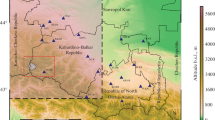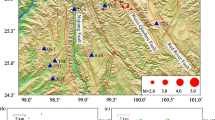Abstract
The triggering mechanism of swarm-like seismicity in the Java Island of Indonesia is generally not well understood. Understanding earthquake swarm phenomena in various tectonic settings can be improved by the detection of micro-earthquakes; however, such a catalog is not available due to various reasons including the existing limited seismic network and using an outdated algorithm for event detection. In this study, we analyze the seismic waveforms and explore the detection capability of small earthquakes during the August 2019 earthquake sequence near Mt. Salak (West Java) by using the known matched filter technique (MFT) and relocated events as templates. We analyze continuous waveforms from seven broadband seismic stations in a 150 km radius around the source center and for a ~ 1 month of data. Our derived complete catalog enables us to analyze the frequency-magnitude distribution of the sequence as well as the spatiotemporal evolution of micro-seismicity. The six largest events were hybrid-like-type volcano-tectonic earthquakes with oblique-thrust mechanisms. The relocation procedure shows that all of the events are located within an area of ~ 2 × 2 km2, probably bounded at 9–12 km of depth. The pattern of seismicity distribution was not clear; however, focal mechanisms might indicate N/NW or E/SE-trending orientation with a steep plane. We detect 280 additional micro-earthquakes to the improved catalog. The b-value of the sequence is close to 1.1, typical for many volcano-tectonic events. We show that the swarm might be initiated by the fluid intrusion into the seismogenic zone while the stress changes from the largest event affected the evolution of swarm.












Similar content being viewed by others
References
Abbes K, Dorbath L, Dorbath C, Djeddi M, Ousadou F, Maouche S, Benkaci N, Slimani A, Larbes S, Bouziane D (2016) The Beni Haoua, Algeria, Mw 4.9 earthquake: source parameters, engineering, and seismotectonic implications. J Seismol 20(2):655–667
Badreldin H (2016) Seismological aspects of the 27 June 2015 Gulf of Aqaba earthquake and its sequence of aftershocks. J Seismol 20(3):935–952
Buurman H, West ME (2010) Seismic precursors to volcanic explosions during the 2006 eruption of Augustine Volcano. In: Power JA, Coombs ML, Freymueller JT (eds) chap. 2The 2006 eruption of Augustine Volcano, Alaska, U.S. Geol. Surv. Prof. Pap., 1769. U.S. Geological Survey, Reston, pp 41–57
Duverger C, Godano M, Bernard P, Lyon-Caen H, Lambotte S (2015) The 2003–2004 seismic swarm in the western Corinth rift: evidence for a multiscale pore pressure diffusion process along a permeable fault system. Geophys Res Lett 42(18):7374–7382
Dziewonski AM, Anderson DL (1981) Preliminary reference Earth model. Phys Earth Planet Inter 25(4): 297–356
Farrell J, Husen S, Smith RB (2009) Earthquake swarm and b-value characterization of the Yellowstone volcano-tectonic system. J Volcanol Geotherm Res 188(1–3):260–276
Greenfield T, Keir D, Kendall JM, Ayele A (2019) Low-frequency earthquakes beneath Tullu Moye volcano, Ethiopia, reveal fluid pulses from shallow magma chamber. Earth Planet Sci Lett 526:115782
Gunawan E, Widiyantoro S (2019) Active tectonic deformation in Java, Indonesia inferred from a GPS-derived strain rate. J Geodyn 123:49–54
Hainzl S (2004) Seismicity patterns of earthquake swarms due to fluid intrusion and stress triggering. Geophys J Int 159(3):1090–1096
Harpel CJ, Stimac J, de Harpel CFAR, Primulyana S (2019) The Orange Tuff: a Late Pleistocene tephra-fall deposit emplaced by a VEI 5 silicic Plinian eruption in West Java, Indonesia. Bull Volcanol 81(6):33
Hill DP (1977) A model for earthquake swarms. J Geophys Res 82(8):1347–1352
Huang Y, Beroza GC (2015) Temporal variation in the magnitude-frequency distribution during the Guy-Greenbrier earthquake sequence. Geophys Res Lett 42(16):6639–6646
Kato A, Terakawa T, Yamanaka Y, Maeda Y, Horikawa S, Matsuhiro K, Okuda T (2015) Preparatory and precursory processes leading up to the 2014 phreatic eruption of Mount Ontake, Japan. Earth Planets Space 67(1):111
Kennett BLN, Engdahl ER (1991) Traveltimes for global earthquake location and phase identification. Geophys J Int 105(2):429–465
Koulali A, McClusky S, Susilo S, Leonard Y, Cummins P, Tregoning P, Meilano I, Efendi J, Wijanarto AB (2017) The kinematics of crustal deformation in Java from GPS observations: implications for fault slip partitioning. Earth Planet Sci Lett 458:69–79
Marliyani GI, Helmi H, Arrowsmith JR, Clarke A (2020) Volcano morphology as an indicator of stress orientation in the Java Volcanic Arc, Indonesia. J Volcanol Geothermal Res 106912
Matoza RS, Shearer PM, Okubo PG (2014) High-precision relocation of long-period events beneath the summit region of Kı̄lauea Volcano, Hawai’i, from 1986 to 2009. Geophys Res Lett 41(10):3413–3421
Meng X, Peng Z, Hardebeck JL (2013) Seismicity around Parkfield correlates with static shear stress changes following the 2003 Mw6.5 San Simeon earthquake. J Geophys Res Solid Earth 118(7):3576–3591
Meng X, Yang H, Peng Z (2018) Foreshocks, b value map, and aftershock triggering for the 2011 Mw 5.7 Virginia earthquake. J Geophys Res Solid Earth 123(6):5082–5098
Parotidis M, Rothert E, Shapiro SA (2003) Pore-pressure diffusion: a possible triggering mechanism for the earthquake swarms 2000 in Vogtland/NW-Bohemia, Central Europe. Geophys Res Lett 30(20)
Passarelli L, Heryandoko N, Cesca S, Rivalta E, Rohadi S, Dahm T, Milkereit C (2018) Magmatic or not magmatic? The 2015–2016 seismic swarm at the long-dormant Jailolo Volcano, West Halmahera, Indonesia. Front Earth Sci 6:79
Peng Z, Zhao P (2009) Migration of early aftershocks following the 2004 Parkfield earthquake. Nat Geosci 2(12):877–881
Perol T, Gharbi M, Denolle M (2018) Convolutional neural network for earthquake detection and location. Sci Adv 4(2):e1700578
Shapiro SA, Huenges E, Borm G (1997) Estimating the crust permeability from fluid-injection-induced seismic emission at the KTB site. Geophys J Int 131(2):F15–F18
Shelly DR, Hill DP, Massin F, Farrell J, Smith RB, Taira TA (2013a) A fluid-driven earthquake swarm on the margin of the Yellowstone caldera. J Geophys Res Solid Earth 118(9):4872–4886
Shelly DR, Moran SC, Thelen WA (2013b) Evidence for fluid-triggered slip in the 2009 Mount Rainier, Washington earthquake swarm. Geophys Res Lett 40(8):1506–1512
Skoumal RJ, Brudzinski MR, Currie BS, Ries R (2019) Temporal patterns of induced seismicity in Oklahoma revealed from multi-station template matching. J Seismol 1-15
Stimac J, Nordquist G, Suminar A, Sirad-Azwar L (2008) An overview of the Awibengkok geothermal system, Indonesia. Geothermics 37(3):300–331
Uchida N (2019) Detection of repeating earthquakes and their application in characterizing slow fault slip. Prog Earth Planet Sci 6(1):40
Uchida N, Bürgmann R (2019) Repeating earthquakes. Annu Rev Earth Planet Sci 47:305–332
Utsu T, Ogata Y (1995) The centenary of the Omori formula for a decay law of aftershock activity. J Phys Earth 43(1):1–33
Van der Elst NJ, Savage HM, Keranen KM, Abers GA (2013) Enhanced remote earthquake triggering at fluid-injection sites in the midwestern United States. Science 341(6142):164–167
Vavryčuk V, Hrubcová P (2017) Seismological evidence of fault weakening due to erosion by fluids from observations of intraplate earthquake swarms. J Geophys Res Solid Earth 122(5):3701–3718
Waldhauser F, Ellsworth WL (2000) A double-difference earthquake location algorithm: method and application to the northern Hayward fault, California. Bull Seismol Soc Am 90(6):1353–1368
Wessel P, Smith WH, Scharroo R, Luis J, Wobbe F (2013) Generic mapping tools: improved version released. EOS Trans Am Geophys Union 94(45):409–410
Wiemer S (2001) A software package to analyze seismicity: ZMAP. Seismol Res Lett 72(3):373–382
Yagi Y, Nishimura N (2011) Moment tensor inversion of near source seismograms. Bull IISEE 45:133–138
Yoon CE, O’Reilly O, Bergen KJ, Beroza GC (2015) Earthquake detection through computationally efficient similarity search. Sci Adv 1(11):e1501057
Yukutake Y, Ito H, Honda R, Harada M, Tanada T, Yoshida A (2011) Fluid-induced swarm earthquake sequence revealed by precisely determined hypocenters and focal mechanisms in the 2009 activity at Hakone volcano, Japan. J Geophys Res Solid Earth 116(B4)
Zobin VM (2012) Introduction to volcanic seismology. Elsevier, vol. 6
Acknowledgments
Earthquake catalog and local/regional waveform data used in this study can be requested from Badan Meteorologi, Klimatologi, dan Geofisika (BMKG). Frequency Index (FI) is computed by using GISMO toolbox for Matlab (geosciences-community-codes.github.io/GISMO). Earthquake relocation is computed using hypoDD code (Waldhauser and Ellsworth 2000). We thank Xiaofeng Meng and Zhigang Peng for the matched filter code (Meng et al. 2013). Statistics is computed by using the ZMAP package (Wiemer 2001). We thank Yuji Yagi for providing the moment tensor inversion code. Figures are created by using the Generic Mapping Tools v4.5.12 (Wessel et al. 2013). We appreciate the constructive suggestions and comments by Yehezkiel Halauwet, Daryono, and Gatut Daniarsyad (BMKG). The authors thank Associate Editor Thomas Braun, Mohammad Youssof (King Abdullah University of Science and Technology - KAUST) and one anonymous reviewer for their comments and suggestions that helped to improve the quality of this work.
Author information
Authors and Affiliations
Corresponding author
Additional information
Publisher’s note
Springer Nature remains neutral with regard to jurisdictional claims in published maps and institutional affiliations.
Electronic supplementary material
ESM 1
(PDF 2667 kb)
Rights and permissions
About this article
Cite this article
Sianipar, D., Sipayung, R. & Ulfiana, E. Excessive seismicity over a limited source: the August 2019 earthquake swarm near Mt. Salak in West Java (Indonesia). J Seismol 24, 1189–1204 (2020). https://doi.org/10.1007/s10950-020-09957-w
Received:
Accepted:
Published:
Issue Date:
DOI: https://doi.org/10.1007/s10950-020-09957-w




